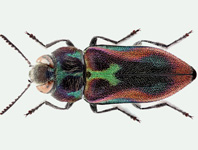Abstract
Members of the genus Gnaphosa belong to the largest gnaphosid spiders. They are particularly interesting in nature conservation as their distribution is mainly restricted to disappearing natural non-forest habitats. In Europe, several Gnaphosa species groups occur. The exclusively Palaearctic group G. bicolor is characterised by a retrolaterally-shifted embolus, which occupies at least part of the middle one-third of the palpal bulb; females have laterally expanded epigyne and often have very elongated median epigynal ducts (Ovtsharenko et al. 1992). So far four species of this group have been identified in Europe, with a fifth species found in Central Asia (G. tarabaevi Ovtsharenko, Platnick & Song, 1992). Two of the European species, G. bicolor (Hahn, 1831) and G. badia (L. Koch, 1866), are well known and their taxonomy and nomenclature is stable, but the same does not hold true for the other two.
References
Chyzer, C. & Kulczyński, W. (1897) Araneae Hungariae. Tomi II-di pars posterior: Zodarioidae, Agalenoidae, Drassoidae, Zoropseoidae, Dysderoidae, Filistatoidae, Calommatoidae, Theraphosoidae. Editio Academiae Scientiarum Hungaricae, Budapest, 226 pp. [pp. 145–370]
Gajdoš, P., Svatoň, J. & Sloboda, K. (1999) Catalogue of Slovakian spiders. Vol. 1 & II. Institute of Landscape Ecology, Slovak Academy of Sciences, Bratislava, 339 pp. & 315 pp.
Grimm, U. (1985) Die Gnaphosidae Mitteleuropas (Arachnida, Araneae). Abhandlungen des Naturwissenschaftlichen Vereins in Hamburg, N.F., 26, 1–318.
Heimer, S. & Nentwig. W. (Eds.) (1991) Spinnen Mitteleuropas: ein Bestimmungsbuch. Verlag Paul Parey, Berlin & Hamburg, 543 pp.
Heneberg, P. & Řezáč, M. (2014) Dry sandpits and gravel sandpits serve as key refuges for endangered epigeic spiders (Araneae) and harvestmen (Opiliones) of Central European steppes aeolian sands. Ecological Engineering, 73, 659–670.
https://doi.org/10.1016/j.ecoleng.2014.09.101Komnenov, M., Pitta, E., Zografou, K. & Chatzaki, M. (2016) Discovering the still unexplored arachnofauna of the National Park of Dadia-Lefkimi-Soufli, NE Greece: a taxonomic review with description of new species. Zootaxa, 4096 (1), 1–66.
https://doi.org/10.11646/zootaxa.4096.1.1Lazarov, S., Deltshev, C. & Blagoev, G. (2001) The spiders (Araneae) of Sashtinska Sredna Gora mountain (Bulgaria). Faunistic and zoogeographical analysis. Acta Zoologica Bulgarica, 53, 3–28.
Lessert, R. de (1910) Araignées. Catalogue des invertebres de la Suisse. Fasc. 3. Museum d’Histoire Naturelle de Genève, Genève, 639 pp.
Ovtsharenko, V.I., Platnick, N.I. & Song, D.X. (1992) A review of the North Asian ground spiders of the genus Gnaphosa (Araneae, Gnaphosidae). Bulletin of the American Museum of Natural History, 212, 1–88.
Pickard-Cambridge, O. (1898) On some spiders from Savoy. Proceedings of the Zoological Society of London, 66 (3), 487–491.
https://doi.org/10.1111/j.1096-3642.1898.tb03170.xŘezáč, M., Kůrka, A., Růžička, V. & Heneberg, P. (2015) Red List of Czech spiders: 3rd edition, adjusted according to evidence-based national conservation priorities. Biologia (Bratislava), 70 (5), 645–666.
https://doi.org/10.1515/biolog-2015-0079Simon, E. (1878) Les arachnides de France. IV. Encyclopédie Roret, Paris, 347 pp.
Simon, E. (1914) Les arachnides de France. VI-1. Synopsis générale et catalogue des espèces françaises de l’ordre des Araneae. Encyclopédie Roret, Paris, 308 pp.
Thaler, K. & Knoflach, B. (2004) Zur Faunistik der Spinnen (Araneae) von Österreich: Gnaphosidae, Thomisidae (Dionycha pro parte). Linzer Biologische Beiträge, 36 (1), 417–484.

